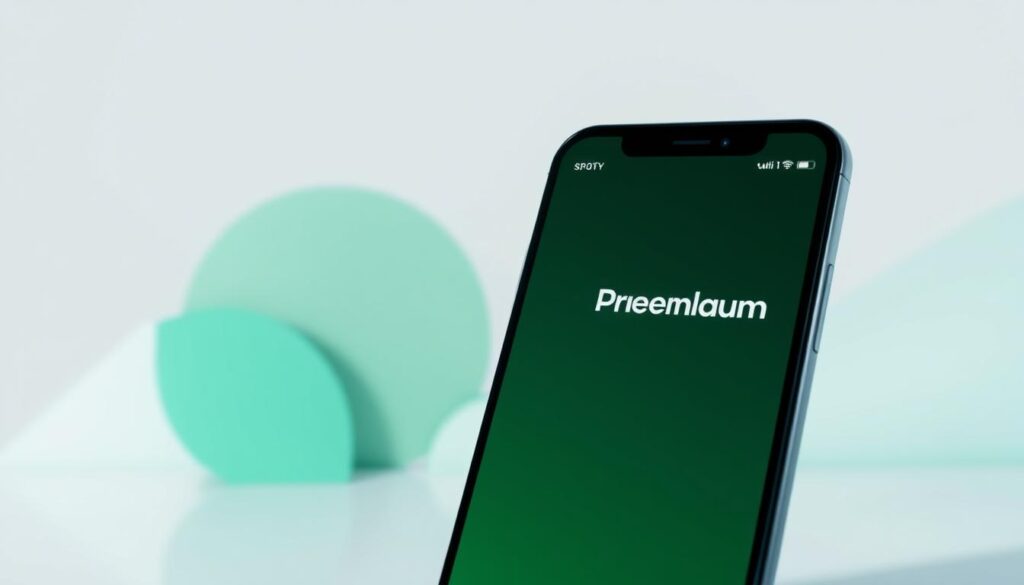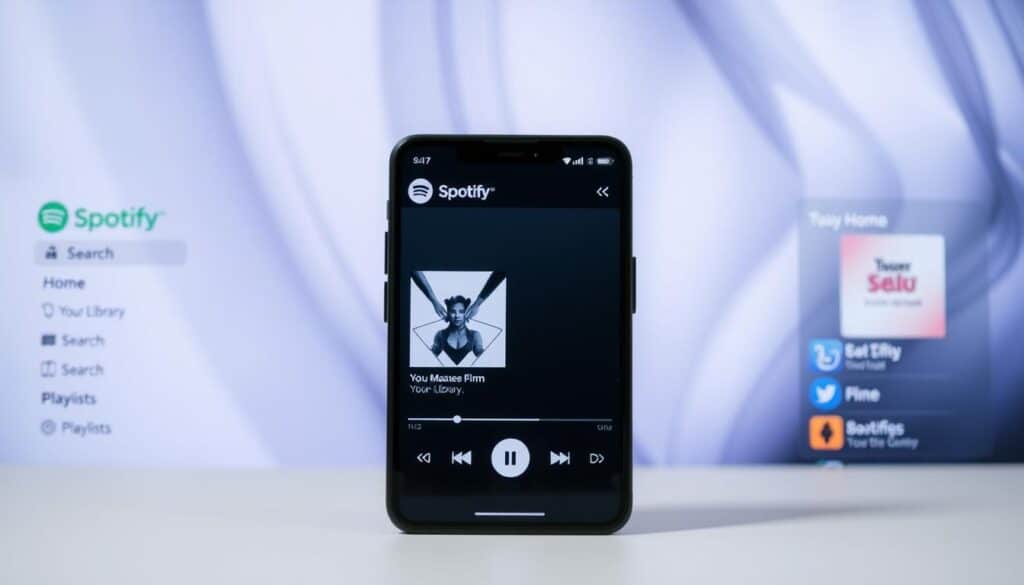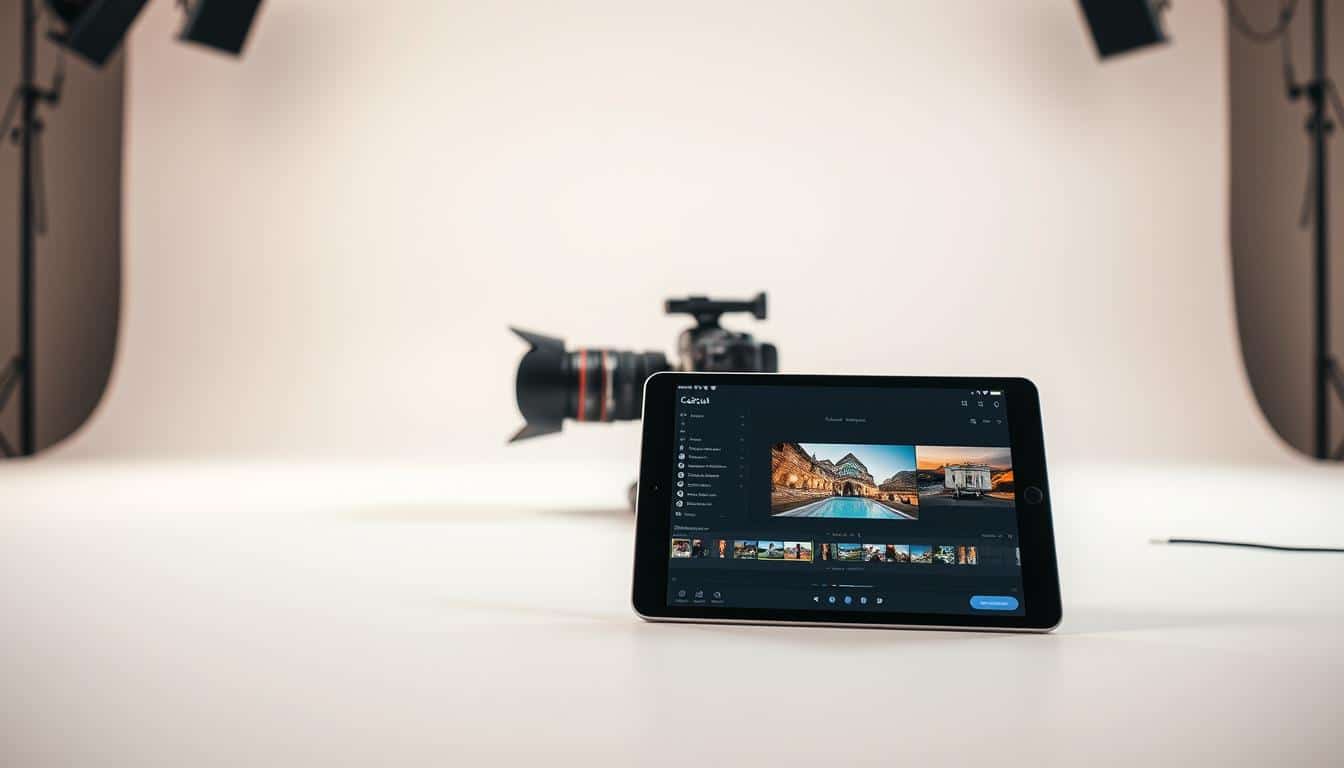Anúncios
Spotify is a top music streaming service from Stockholm, known in Spotify US. It lets users play millions of songs and podcasts whenever they want. You can listen to music while traveling or enjoy podcasts during exercise. Spotify has both curated and personalized playlists for your liking.
Anúncios
There’s a Free, ad-upported version and several Premium plans without ads and with offline play. You’ll find Discover Weekly for new music, the yearly Wrapped summary, tools for artists, exclusive podcasts, and easy sharing options.
People use Spotify for daily travels, playing music at work, episodes for exercise, or to find new music and podcasts. In the U.S., Spotify is a go-to for tailored playlists, listening on any device, and accessing a huge selection of audio.
Anúncios
Key Takeaways
- Spotify lets you stream music and stream podcasts from a massive catalog.
- Personalized playlists like Discover Weekly tailor recommendations to your tastes.
- Choose between Free (ad-supported) and Premium plans for offline listening.
- Spotify for Artists and podcast hosting support creators and exclusive content.
- Ideal for commuting, workouts, work playlists, and discovering new music.
What is Spotify and How It Works
Spotify is a service that streams music and podcasts. It gets content from major labels, indie artists, and producers. You can join for free with ads and some limits. Or, go Premium for no ads and to download music to listen offline. It offers millions of songs, playlists, mixes, and exclusive podcasts.
Overview of the platform
Spotify works by using accounts. There is a free version and a paid Premium version. The free version has ads and limits on skips. The Premium version lets you download music, offers better sound, and has no ads. Spotify’s playlists are made by their team, by users, and by algorithms that learn what you like.
How streaming differs from downloads
Streaming means you listen to music on the internet without saving it on your device. It requires a good internet connection. Downloads are files you keep, like MP3s. They stay on your device even if you stop using the service.
With Spotify Premium, you can download songs. But, you must check in online sometimes to keep your downloads. Streaming uses data. Listening to lower quality saves data. Downloading music is good for saving data when traveling or if your internet is unreliable.
Supported devices and operating systems
Many devices work with Spotify. There are apps for phones, tablets, computers, and even some Linux versions. Plus, there’s a web player for browsers like Chrome. You can also use Spotify on smart TVs, game consoles, and in cars with Apple CarPlay or Android Auto.
You can also use Spotify on lots of home devices. This includes Sonos, Roku, and speakers with Alexa or Google Assistant. You can connect with Bluetooth or AirPlay too. Make sure to keep your app up-to-date for the best experience and new features.
Spotify – Music and podcast streaming with personalized playlists.
Spotify mixes music and podcasts in one app, promising playlists made just for you. It makes finding new music and shows quick and matches what you feel like listening to. This way, you discover artists and podcasts that you’ll love.
Breaking down the main keyword: what it means for users
With “Music and podcast streaming with personalized playlists,” you get songs and podcasts all in one spot. This is thanks to playlists made just for you. You’ll find new favorites faster and enjoy a listening experience designed for your tastes.
How personalization powers playlists and recommendations
Spotify’s personalization uses both tech and human touch. It looks at what others listen to and understands song details and genres. It even checks the music’s feel and tempo. Spotify also gets help from experts who add their favorite picks.
The tech behind Spotify suggests new discoveries like Discover Weekly and Release Radar. It recommends songs to add to your own playlists too. This keeps your music fresh and in flow.
When you skip, save, follow, or like a song, Spotify learns. It uses your actions to make better suggestions next time. This way, your playlists keep getting better and more suited to your taste changes.
Podcast integration alongside music listening
Spotify puts podcasts right up there with music. You can go from a song to a podcast episode easily. Podcasts show up in search results and your personalized feed too.
For podcast fans, Spotify tailors suggestions based on what you follow and listen to. It helps you find new shows and episodes you’re interested in. You can even mix podcasts with songs for a seamless listening experience.
Spotify Free vs Premium: Features and Pricing

Choosing between Spotify Free and Spotify Premium depends on your listening habits. Free lets you access all music and podcasts, but you’ll hear ads. You’ll also face some limits on mobile and get lower sound quality. With Premium, ads disappear, you can download music, and enjoy better sound and on-demand plays.
What you get with Spotify Free
Spotify Free is great for ad-supported listening on various devices. On mobile, you might have to shuffle songs and face skip limits. Ads play between tracks, and the sound quality isn’t as high. Yet, you can still enjoy Discover Weekly, follow artists, and use the Web Player. However, you can’t listen offline with Free.
Benefits of Premium plans
With Spotify Premium, say goodbye to ads, and hello to unlimited skips and on-demand listening. Enjoy the best streaming quality and download music to listen offline. Features like crossfade and richer sound settings make listening even better. And it’s all under a cancel-anytime monthly subscription.
Student, Duo, Family, and Individual plan comparisons
Students get discounts and sometimes Hulu or SHOWTIME. Duo is for two people sharing an address, offering a mixed playlist of both tastes. The family plan allows up to six members, includes a Family Mix, and blocks explicit content. Individual plans give one person all Premium benefits.
| Plan | Key Perks | Best For |
|---|---|---|
| Free | Ad-supported, shuffle on mobile, personalization, no offline | Casual listeners who tolerate ads |
| Individual (Premium) | Ad-free, offline downloads, highest audio quality, unlimited skips | Single users who want the full experience |
| Duo | Two Premium accounts, Duo Mix playlist, shared address requirement | Couples or roommates living together |
| Family | Up to six accounts, Family Mix, parental controls, shared address verification | Households with multiple listeners |
| Student | Discounted Premium, verification required, occasional bundle offers | College students seeking lower cost |
Spotify pricing changes, so always check the official pricing page for the latest. Comparing options lets you choose the best plan for your budget and how you like to listen.
Discovering Music: Playlists, Radio, and Discover Weekly
Spotify uses both human experts and technology to find new music. Teams of people and algorithms work together. They make playlists and use features like Discover Weekly to suggest new songs based on what you like.
How curated playlists work
Spotify’s playlists come from their own team, music labels, and artists. They update these lists often to keep up with new music and what listeners want. Sometimes, special playlists are made to showcase artists to more people.
When new and known artists appear on playlists, it can make them more popular. If a playlist has a specific vibe, it can really stand out.
Understanding algorithmic playlists like Discover Weekly
Discover Weekly updates every week with songs picked just for you. It looks at what you’ve listened to and finds new songs you might like. Spotify explains why they picked each song, which makes the choices clear.
Features like Release Radar, Daily Mixes, and Autoplay keep your music fresh. They choose songs based on your taste without you having to search for them.
Creating and sharing your own playlists
To make a playlist, just add songs you find or get recommended. You can sort them by how they feel and even add your own cover art. Turn on collaborative mode to let your friends add songs, too. The best playlists have a strong theme and regular updates.
You can share your playlists on social media or your website. If you create great playlists, you can submit them to Spotify. They might feature them for even more people to see.
Podcasts on Spotify: Find, Follow, and Listen
Spotify makes finding podcasts easy. Search using keywords, host names, or topics. You’ll get a mix of shows and episodes. Looking for true crime, news, comedy, or education? Filters and genre pages are there to help. Discovery is fast with curated hubs and topic collections.
Hit Follow to add a show to Your Library. That way, new episodes show up in Home and your feed. Podcast subscriptions are similar to follows. They keep episodes tidy and alert you about new ones. Plus, they sync across your devices. So, you can continue listening on your phone or computer.
Episode controls are all about making listening easy. Play, add to queue, or download episodes for when you’re offline. Features like playback speed, silence trimming, and chapter markers let you manage time better. To revisit important parts, use bookmarks or timestamps.
Show notes offer descriptions, chapter markers, guest info, and links. They help you decide if an episode is worth your time. You’ll often find useful resources and references there. Downloads and offline access are mindful of your device’s storage. Both free and Premium users enjoy these benefits.
Spotify is all in on original content and exclusive rights. This strategy aims to bring in new listeners. Deals with creators mean some shows are only on Spotify. This sets Spotify apart from other podcast apps.
The table below shows common podcast features on Spotify and their benefits.
| Feature | How it works | Benefit |
|---|---|---|
| Search by keyword, host, topic | Returns shows and episodes; includes filters and categories | Fast discovery across genres like true crime and news |
| Follow / podcast subscriptions | Tap Follow to add shows to Your Library; new episodes appear in Home | Keeps favored shows organized and synced across devices |
| Episode playback | Play, queue, change speed, trim silence, use chapter markers | Customizable listening for time and preference |
| Offline listening | Download episodes for travel; sync across devices; storage limits apply | Listen without signal during flights or commutes |
| Show notes and metadata | Episode descriptions, links, guest info, timestamps | Quickly assess content and follow references |
| Spotify Originals and podcast exclusives | Platform-produced shows and exclusive licensing deals | Unique content that can attract new listeners to Spotify |
User Experience: Apps, Interface, and Accessibility

This section talks about how to use Spotify better on different devices. You’ll find tips that make navigating the app quicker and listening smoother. Just a few small changes can really improve your experience.
Mobile and desktop app navigation tips
Start with Home for music and podcasts just for you. Use Search to find new favorites. Your Library lets you quickly get to your saved stuff. And with Queue, you can change the order of what plays next easily.
Get to know the playback controls like play, pause, and skip. Use crossfade in the settings for smoother song changes. Spotify Connect lets you switch the sound from your phone to your speaker with just a tap.
To listen without internet, manage your downloads. Clear the app cache to keep things running fast. Making and organizing playlists is easier with drag-and-drop on desktop. These tips cut down on buffering and keep your music collection tidy.
Voice commands and integrations
Spotify in the car gets safer with CarPlay and Android Auto. They make it easy to pick music with big buttons and voice commands, so you can stay focused on driving.
With Alexa or Google Assistant, you can do things like play specific songs with just your voice. Connect Spotify to each assistant for full control on smart devices.
Use Spotify Connect for controlling speakers from your gadgets. It’s compatible with many brands, letting you transfer sound seamlessly between devices.
Accessibility features for diverse listeners
Spotify works with screen readers like VoiceOver for iOS and TalkBack for Android. On desktops, you can navigate using the keyboard and adjust for better visibility.
Make text bigger in your device settings to see better. Speed up or slow down podcast playback and skip silences to understand clearly and save time. These features help each listener have a better Spotify experience.
Spotify keeps updating its accessibility tools. Check the app settings and their help pages for the latest features that make Spotify great for everyone.
| Area | Tip | Benefit |
|---|---|---|
| Home & Search | Use Home for daily mixes and Search for new artists | Faster discovery and personalized listening |
| Your Library & Queue | Organize with playlists and edit the Queue often | Cleaner library and smoother playback control |
| Playback Settings | Enable crossfade, adjust shuffle, set repeat | Smoother transitions and customized listening |
| In-car Integration | Use CarPlay Spotify or Android Auto for driving | Safer controls and simpler browsing on the road |
| Smart Speakers | Link account to use Alexa Spotify or Google Assistant | Hands-free playback and voice-driven control |
| Accessibility | Enable VoiceOver/TalkBack, use larger text, keyboard nav | Better access for listeners with diverse needs |
| Performance | Manage downloads and clear cache periodically | Reduced lag and more reliable streaming |
Tips to Improve Recommendations and Personalization
To get better Spotify suggestions, you need to do a few things. Small habits help shape what Spotify suggests to you. By focusing on what you listen to, you can get better recommendations.
Spotify looks at songs you play over and over, finish, or skip. Listening again and completing songs tells Spotify what you like. Skipping songs often tells it you don’t like those tracks.
If you want to discover more of a certain genre, listen longer. Aim for 30–60 minutes with playlists in that style. Short and random plays don’t help change your recommendations much.
Using likes, follows, and playlist saves effectively
Hitting the heart button puts tracks in your Liked Songs. This shapes your personalized mixes. Following artists or podcasts and saving albums or playlists also impacts your future suggestions.
Make playlists for specific moods or activities, like a “workout rock” playlist. This teaches Spotify your detailed preferences. Use the “Don’t play this” feature to block songs or artists you don’t like from your recommendations.
Managing your taste profile and privacy settings
You can control your listening data on Spotify. Using a private session stops one session from changing your taste profile. Turning off sharing keeps what you play private from friends.
To get rid of bad recommendations, unlike songs or remove tracks. Check your privacy settings to control data sharing. You can also ask Spotify for your data to see what’s being collected. These steps let you keep your Spotify privacy and recommendations just right.
Music Licensing, Artists, and Monetization on Spotify
Streaming services like Spotify collect money from ads and subscriptions. They then pay musicians and other rights holders based on contracts. How much artists, songwriters, and their labels get depends on several factors. This includes how many times songs are played, their market presence, and the payment model Spotify uses.
How artists get paid and streaming royalties explained
Spotify puts aside a specific amount for those who own music rights. Record labels and publishers often get this money first. They then pay the artists according to their contracts. Indie artists might use services like DistroKid or CD Baby to get their money directly.
Royalty payments can change based on location and deals with Spotify. The industry keeps discussing how to make payments fairer, especially for less known musicians. Keeping an eye on your song plays and making sure your song details are correct is crucial for earning more.
Tools for artists: Spotify for Artists and promotion
Spotify gives artists a special dashboard to manage their profiles, music, and see who’s listening. You can also ask Spotify to include your songs in their playlists, share special visuals, and learn about your listeners to plan your music better.
There are tools to help promote your music, like Marquee, playlist pitching, and setting up pre-save campaigns. Being verified, sharing your top song choices, selling merch, or tickets can also help make more money from your music. Planning music releases through Spotify makes promotion smoother.
Independent musician strategies on Spotify
Being independent on Spotify means releasing music regularly, making sure your music info is correct, and having eye-catching cover art. Releasing single tracks frequently can be better than waiting a long time between albums. Look at Spotify’s data to see where your fans are for tours or ads.
Working on getting your music on playlists, being active on social media, and teaming up with playlist creators can grow your fanbase. Also, selling merch, doing live gigs, and using platforms like Bandcamp or Patreon are great ways to earn more money from your music.
| Area | Practical Tip | Expected Benefit |
|---|---|---|
| Claim profile | Use Spotify for Artists to verify and customize your page | Higher trust and better conversion of listeners to followers |
| Release cadence | Schedule regular singles or EPs, not long gaps | Sustained playlist interest and algorithmic boosts |
| Metadata | Ensure accurate credits, ISRCs, and genre tags | Correct royalty allocation and playlist discoverability |
| Promotion | Pitch to editorial playlists and run Marquee campaigns | Short-term spike in streams and follower growth |
| Diversified income | Sell merch, ticket bundles, and use Patreon or Bandcamp | Stable revenue outside fluctuating Spotify royalties |
Conclusion
Spotify offers a huge music library and a growing podcast catalog. It has strong tools that learn what you like. You can listen on many devices, like phones, computers, speakers, and in cars. This makes Spotify great for daily use and finding new music.
Choosing Spotify means looking at what you get and what you miss. The free version has ads and limits on offline listening. With Premium, you don’t get ads, can download music, and the sound is better. Artists use Spotify for Artists to share their music and learn about their fans. Independent creators can also find an audience with playlists and podcasts.
To shape the music Spotify suggests to you, start with personalized playlists. Discover Weekly is a good place to begin. Save songs, follow shows, and change your settings to improve what Spotify recommends. If you’re in the US, check Spotify’s site for the latest prices before upgrading. Try Premium for better sound and no ads.
This summary is clear: Spotify is great for daily music, finding new sounds, and podcasts. Use features like liking songs, following artists, and making playlists to tailor your listening. It helps Spotify know what to play for you next.
FAQ
What is Spotify and how does it work?
How is streaming on Spotify different from downloading music?
Which devices and platforms support Spotify?
What does “Music and podcast streaming with personalized playlists” mean?
How does Spotify personalize playlists and recommendations?
Can I listen to podcasts and music in the same queue?
What are the differences between Spotify Free and Premium?
What Premium plans are available and how do they compare?
How do curated playlists differ from algorithmic playlists like Discover Weekly?
How do I create and share my own playlists?
How do podcast subscriptions and features work on Spotify?
Does Spotify offer exclusive or original podcasts?
What navigation tips improve the Spotify app experience?
How do voice commands and smart integrations work with Spotify?
What accessibility features does Spotify provide?
How can I improve my recommendations on Spotify?
How does Spotify handle privacy and my listening data?
How do artists get paid on Spotify?
What tools does Spotify offer for artists and promotion?
What strategies help independent musicians succeed on Spotify?
Conteúdo criado com auxílio de Inteligência Artificial



